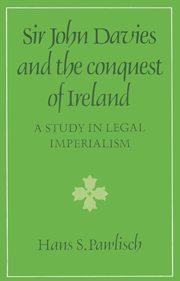Book contents
- Frontmatter
- Contents
- Preface
- Abbreviations
- PART I INTRODUCTION
- PART II JUDICIAL ENCOUNTERS: THE NATIVE COMMUNITY
- 4 The cases of gavelkind and tanistry: legal imperialism in Ireland, 1603–1610
- 5 The case of the Bann fishery
- PART III JUDICIAL ENCOUNTERS: THE COLONIAL COMMUNITY
- PART IV CONCLUSION
- Notes
- Select bibliography
- Index
- Cambridge Studies in the History and Theory of Politics
4 - The cases of gavelkind and tanistry: legal imperialism in Ireland, 1603–1610
from PART II - JUDICIAL ENCOUNTERS: THE NATIVE COMMUNITY
Published online by Cambridge University Press: 13 October 2009
- Frontmatter
- Contents
- Preface
- Abbreviations
- PART I INTRODUCTION
- PART II JUDICIAL ENCOUNTERS: THE NATIVE COMMUNITY
- 4 The cases of gavelkind and tanistry: legal imperialism in Ireland, 1603–1610
- 5 The case of the Bann fishery
- PART III JUDICIAL ENCOUNTERS: THE COLONIAL COMMUNITY
- PART IV CONCLUSION
- Notes
- Select bibliography
- Index
- Cambridge Studies in the History and Theory of Politics
Summary
The previous chapter summarizing the contents of Sir John Davies' Reports introduced the role of judicial resolutions in consolidating the Tudor conquest of Ireland. The single most important example of the use of such resolutions was their application against the customary patterns of Gaelic succession and land tenure known as tanistry and gavelkind. The need for judicial action to void native forms of landholding and descent became clear to Davies when he analysed the barriers to English sovereignty in Ireland raised by the manner in which land was used and owned in the Gaelic districts. Like other administrators concerned with the legal status of the Gaelic polity, Davies saw the extension of common law tenures to the formerly autonomous Gaelic lordships as the most important pre-condition of the exercise of English sovereignty in Ireland. The decision to employ extra-judicial resolutions, or legal decisions divorced from litigation pending in the central courts, involved the Irish judiciary in the formulation of a policy that aimed at assimilating an alien scheme of law and land tenure into the new state system.
Davies' reflections on the problems posed for English rule by the existence of the autonomous Gaelic lordships are revealed in the Reports and the Brief Discovery. Davies concurred with Bodin's civil law maxim that ‘a king is not sovereign where others give law without reference to him’.
- Type
- Chapter
- Information
- Sir John Davies and the Conquest of IrelandA Study in Legal Imperialism, pp. 55 - 83Publisher: Cambridge University PressPrint publication year: 1985



